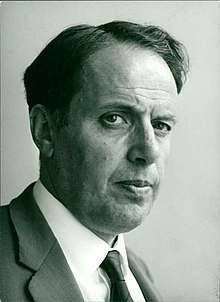Rudolf Meidner
Rudolf Alfred Meidner (23 June 1914 – 9 December 2005) was a Swedish economist.
Rudolf Meidner | |
|---|---|
 Rudolf Meidner (1966) | |
| Born | Rudolf Alfred Meidner 23 June 1914 |
| Died | 9 December 2005 (aged 91) |
| Nationality | German, Swedish |
| Alma mater | Stockholm University |
| Known for | Rehn-Meidner model |
| Spouse(s) | Ella Jörgenssen (m. 1937) |
| Scientific career | |
| Fields | Economics, Politics, Sociology |
| Institutions | Stockholm University, Swedish Trade Union Confederation |
| Doctoral advisor | Gunnar Myrdal |
Biography
Son of Alfred Meidner and Elise Bandmann, Meidner was born on 23 June 1914 in Breslau, Silesia. He was forced to flee Nazi Germany after the Reichstag fire in Berlin 1933, being Jewish and a socialist.
In 1937, Meidner married Ella Jörgenssen and became a citizen of Sweden in 1943.[1]
Meidner was an economist and the developer of the employee funds plan proposed by the Swedish Trade Union Confederation in the 1970s. He studied under famous economist and Nobel Prize Winner Gunnar Myrdal. He got his PhD in 1954 with a dissertation labeled "Swedish Labour Market at Full Employment". He spent most of his work life at the Swedish Trade Union Confederation as a researcher.
Meidner died on 9 December 2005 in Lidingö, aged 91.
Rehn-Meidner model
Meidner and Swedish economist Gösta Rehn were responsible for the Rehn–Meidner model for economic growth as promulgated by the Swedish Social Democratic Party and the LO. the blue-collar trade union. The Rehn–Meidner model was first proposed in 1951 and for over the next twenty-five years was the basis for the low-inequality, high-tech oriented, rapid-innovation Swedish economy which also was exposed to international trade and became export oriented. In response to the increasing demand on the part of workers, communities and women for a share of the excess profits (permitted by a capital-labor-state wage suppression agreement) accumulated in an increasingly powerful capitalist sector, Meidner created a proposal in 1976, published by the LO, that called for requiring all companies above a certain size to issue new stock shares to workers so that within twenty years the workers would control 52% of the companies they worked in. This policy followed in Meidner's career-long efforts to build a step-wise, peaceful, institutionally supported transition to a socialist society, whose carefully crafted incentive structure and culture would allow each member of society to work and contribute according to her or his capacity and receive social support according to her or his needs.[2]
Supported by important Swedish policy designer Walter Korpi, Meidner's work was opposed by pro-capitalist Social Democrats, including the aggressively conservative Finance Minister Kjell-Olof Feldt as well as Gosta Rehn (proponent of active labour market policies) and Olof Palme.[2] The increasing ambitions and occasional militancy of the Swedish working class in conjunction with Meidner's careful, progressive socialist institutional planning politicized the Swedish capitalist class via the Swedish Employers Association (SAF), who joined other countries' capitalist classes ramping up their political efforts to destroy working class organizational bases and to promote the capital deregulation and mobility that began to come to crisis in the 2000s.[2][3] The SAF's response was to model their political and policy strategies after the New Zealand capitalist class' campaign which had successfully destroyed a labor movement of similar strength to the Swedish labor movement.[2]
The Rehn–Meidner model resulted in Sweden having a very egalitarian wage system so that wage differentials between professions was very low, fortifying a low Gini coefficient. However, in the absence of the socialist steps urged by Meidner in the 1970s the economic model resulted in capital concentration (despite a very active social policy, Sweden has one of the highest percentages of private ownership of capital in the world) to the point where in the late 1970s 25% of share capital was held by the top 0.1% of shareholders and 75% by the top 10%. For the time being, the progressive taxation and pro-middle class state institutions promoted by the model extensively ameliorate this capital concentration as can be seen in comparatively successful, egalitarian outcomes.[4]
References
- In Memory of Rudolf Meidner (1914-2005)
- Olsen, Gregg. The Struggle for Economic Democracy in Sweden.
- Vogel. Fluctuating Fortunes.
- Schmitt, John and Ben Zipperer. 2006. "Is the U.S. a Good Model for Reducing Social Exclusion in Europe?" The Post-autistic Economics Review, 40 (1).
- Socialism: A Very Short Introduction, Michael Newman (Oxford University Press, 2005)
External links
- Rudolf Meidner, "Why Did the Swedish Model Fail?" (Socialist Register, 1993)
- Robin Blackburn, "Rudolf Meidner, A Visionary Pragmatist"